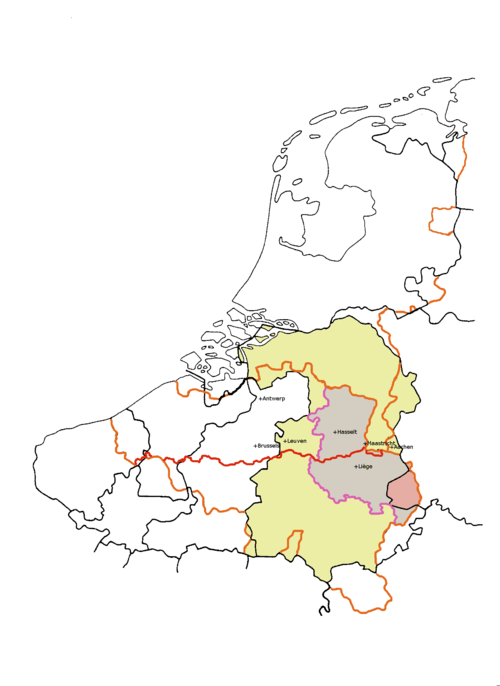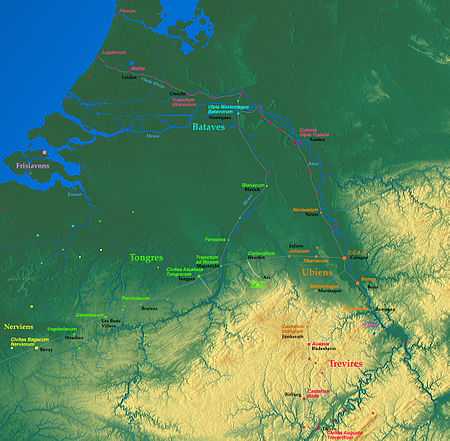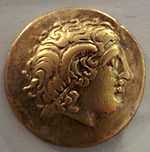Tungri
The Tungri (or Tongri, or Tungrians) were a tribe, or group of tribes, who lived in the Belgic part of Gaul, during the times of the Roman empire. They were described by Tacitus as being the same people who were first called "Germani" (Germanic), meaning that all other tribes who were later referred to this way, including those in Germania east of the Rhine river were named after them. Their name is the source of several place names in Belgium, Germany and the Netherlands, including Tongeren, and several places called Tongerloo, and Tongelre.[1]
Origins
In a comment in his Germania, Tacitus remarks that Germani was the original tribal name of the Tungri with whom the Gauls were in contact; among the Gauls the term Germani came to be widely applied.[2]
The name Germany, on the other hand, they say, is modern and newly introduced, from the fact that the tribes which first crossed the Rhine and drove out the Gauls, and are now called Tungrians, were then called Germans [Germani]. Thus what was the name of a tribe, and not of a race, gradually prevailed, till all called themselves by this self-invented name of Germans, which the conquerors had first employed to inspire terror.[3]
Some generations earlier, Julius Caesar, on the other hand, does not mention the Tungri, but does say that the Condrusi, the Eburones, the Caeroesi and the Paemani, living in the same approximate area as the later Tungri, were "called by the common name of Germans (Germani)" and had settled in Gaul already before the Cimbric wars, having come from Germany east of the Rhine. The Romans allies named them as having one collective contribution of men to the Belgic revolt against him, within which the Eburones were the most important. They were led by Ambiorix and Cativolcus.[4] Also neighbouring these tribes where the Aduatuci, whose origin Caesar describes more specifically as having descended from the Cimbri and Teutones, against whom the Germani had been the only Gaulish tribe to successfully defend themselves.[5] Their descendants, if there were any, presumably lived amongst the Tungri.

Already during the campaign of Caesar, the Tencteri and Usipetes crossed the Rhine for a cattle raid of the territories the Menapii, Eburones and Condrusi, giving Caesar an excuse for new military intervention in the area. He pursued them back over the Rhine where they were helped by the Sicambri. Later, Caesar himself encouraged the Sicambri to cross the Rhine into the territory of the Eburones, seeking to plunder the lands of the people whose fortress he had just taken.[6] These tribes who crossed the Rhine and became part of Roman Germania Inferior were themselves apparently heavily influenced by Gaulish culture, some using Gaulish personal names or Gaulish tribal names.
Later, as the area became part of the Roman empire some of these tribes from over the Rhine, including Sicambri and Ubii, were forced by Tiberius to settle among in the northeast of Gaul, and Romanised provinces with tribal names developed from the mergers of incoming groups, with people who had lived there before Caesar. This is the apparent origin of both the Tungri the other tribal groups of Germania Inferior.[7]
The exact history of each such mergers is unknown, although the areas nearer to the Rhine appear to have had larger scale immigration while the Tungri are often suspected of being less changed in their make-up by this process.[8] Smaller tribal groups such as the Condrusi (one of the Germani tribes mentioned by Caesar) and the Texuandri (maybe the same as the Eburones) continued to exist as recognized groups for the administrative purpose of mustering troops.[9] To the north of the Tungri, in the Rhine-Maas delta were the Batavians, a similarly new formation, apparently made up of in-coming Chatti, with a possible contribution of Eburones. To the northeast of the Tungri, near the Rhine were the Cugerni, who are thought to be Sicambri, and then around the area of Cologne and Bonn the Ubii were settled.[10][11]
Location

Pliny the Elder is the first writer to mention the Tungri in Gallia Belgica, in his Natural History.[12] He notes that their territory
...has a spring of great renown, which sparkles as it bursts forth with bubbles innumerable, and has a certain ferruginous taste, only to be perceived after it has been drunk. This water is strongly purgative, is curative of tertian fevers, and disperses urinary calculi: upon the application of fire it assumes a turbid appearance, and finally turns red
It has been suggested that this refers to the well-known waters of Spa in the province of Liège,[13] or else to waters found at Tongeren, which are suitably iron-bearing, and today referred to as the "Plinius bron".[14]
Both Pliny and Ptolemy's Geography are unclear concerning the exact position of the Tungri but are understood as placing them east of the Scheldt, and to the north of the Arduenna Silva (Forest of Ardennes), along the middle and lower valley of the Mosa (Meuse River).
Their tribal capital lay at Atuatuca (or Aduatuca) Tungrorum, probably modern Tongeren in the Limburg province of Belgium (the word Atuatuca is thought to have probably meant fortress). Under the Romans, the Tungri civitas was first a part of Gallia Belgica, and later split out to join the territories of the Ubii to the southeast, and the Cugerni, who are generally equated with being descended from the Sicambri, to the northeast, and become part of Germania Inferior, and still later it became part of Germania Secunda. In other directions, their neighbours in Roman times were the Belgic Nervii on the west and the Remi and Treveri to the south, all tribes who had been in those regions since before Caesar's campaign.[15]
Part of the empire
Tacitus in his Histories[16] notes two cohorts of Tungri in the civil war of 69 AD.
The Tungri were mentioned in the Notitia Dignitatum, an early fifth-century document, in which was transcribed every military and governmental post in the late Roman Empire. The document mentions the Tribune of the First Cohort of Tungri stationed at Vercovicium (now known as Housesteads, Northumberland) on Hadrian's Wall. The cohort was split in Hadrianic times to form a Second Cohort of Tungri as well, both cohorts 1000 men strong (milliary cohorts).
Notes
- ↑ Moerman (1956), Nederlandse Plaatsnamen, Brill, p. 236
- ↑ The passage, whose text is sound, has occasioned a huge literature of commentary; "some of the problems stem from the fact that people have wanted this section to provide more abundant and precise information than it in fact does," J.B. Rives remarked (Ribes, translator, Cornelius Tacitus: Germania (Oxford University Press) 1999:117.
- ↑ "Germania" chapter 2. "ceterum Germaniae vocabulum recens et nuper additum, quoniam qui primi Rhenum transgressi Gallos expulerint ac nunc Tungri, tunc Germani vocati sint: ita nationis nomen, non gentis, evaluisse paulatim, ut omnes primum a victore ob metum, mox et a se ipsis invento nomine Germani vocarentur"
- ↑ De Bello Gallico 2.4
- ↑ De Bello Gallico 2.29
- ↑ De Bello Gallico 6.35
- ↑ Wightman, Edith Mary (1985), Gallia Belgica, University of California Press page 53.
- ↑ Nico Roymans, Ethnic Identity and Imperial Power. The Batavians in the Early Roman Empire. Amsterdam Archaeological Studies 10. Amsterdam, 2004. pages 4 and 19.
- ↑ Wightman, Edith Mary (1985), Gallia Belgica, University of California Press page 53-54.
- ↑ Wightman, Edith Mary (1985), Gallia Belgica, University of California Press pages 37, 45, etc.
- ↑ Nico Roymans, Ethnic Identity and Imperial Power. The Batavians in the Early Roman Empire. Amsterdam Archaeological Studies 10. Amsterdam, 2004. pages 24 and 43.
- ↑ Natural History IV.31 and XXXI.8.
- ↑ MacBean, Alexander; Johnson, Samuel (1773), A dictionary of ancient geography
- ↑ http://books.google.be/books?id=BAhBAAAAcAAJ&pg=PA99
- ↑ Wightman, Edith Mary (1985), Gallia Belgica, University of California Press
- ↑ Tacitus, Histories, ii.14.1 and ii.28.1.
See also
- List of Germanic tribes
| |||||||||||||||||||||||||
| ||||||||||||||||||||||||||||||||||||||||||
External links
- Roman Britain website: Cohors Primae Tvngrorvm

